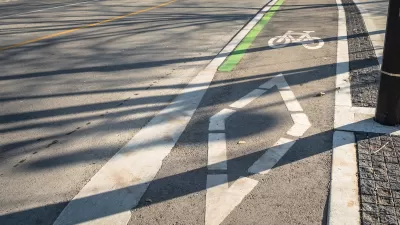Denver is in the process of rolling out a transportation experiment to the residents of the region: separating street space for transit and active transportation can serve all users and doesn't have to be the end of the world for drivers either.

Jon Murray checks in with the transportation situation on Broadway south of Downtown Denver, where last summer the city installed a two-way bike lane and removed a lane of vehicle traffic between Bayaud and Virginia avenues. According to Murray, Broadway funnels the heaviest traffic out of Downtown—about 32,000 drivers use the street every day. As "frustrating" as the changes have been for some rivers, writes Murray, the changes were welcomed by bike advocates and the change "is a signal of the future of commuting in Denver."
"As the city grapples with a surging population, intensifying traffic at all hours of the day and high demand for driving alternatives, public works officials increasingly are dividing up precious pavement, ending the decades of supremacy enjoyed by cars," according to Murray.
The pilot project on Broadway provides proof of concept, according to local transportation planners, that reducing traffic lanes doesn't necessarily slow travel times for cars, while it increases the potential capacity of the road. With evidence of the lane's success in serving all users (not just "auto-driving suburbanites," as Ken Schroeppel, an assistant professor in urban planning at the University of Colorado Denver, puts it in the article) in place, the city is preparing to expand the transit and bike lanes on the street.
FULL STORY: Denver’s commuter corridors, including Broadway, are no longer just for cars. Will that cause strife?

Alabama: Trump Terminates Settlements for Black Communities Harmed By Raw Sewage
Trump deemed the landmark civil rights agreement “illegal DEI and environmental justice policy.”

Planetizen Federal Action Tracker
A weekly monitor of how Trump’s orders and actions are impacting planners and planning in America.

Why Should We Subsidize Public Transportation?
Many public transit agencies face financial stress due to rising costs, declining fare revenue, and declining subsidies. Transit advocates must provide a strong business case for increasing public transit funding.

Blinded by the Light: When Brighter Headlights Decrease Safety
Bright LED headlights can create glare and reduce visibility for other drivers and pedestrians.

Study Links Covid and Poor Driving
The effects of the virus, including ‘brain fog,’ can make driving more difficult and dangerous.

Waymo Gets Permission to Map SF’s Market Street
If allowed to operate on the traffic-restricted street, Waymo’s autonomous taxis would have a leg up over ride-hailing competitors — and counter the city’s efforts to grow bike and pedestrian on the thoroughfare.
Urban Design for Planners 1: Software Tools
This six-course series explores essential urban design concepts using open source software and equips planners with the tools they need to participate fully in the urban design process.
Planning for Universal Design
Learn the tools for implementing Universal Design in planning regulations.
Caltrans
Smith Gee Studio
Institute for Housing and Urban Development Studies (IHS)
City of Grandview
Harvard GSD Executive Education
Toledo-Lucas County Plan Commissions
Salt Lake City
NYU Wagner Graduate School of Public Service




























